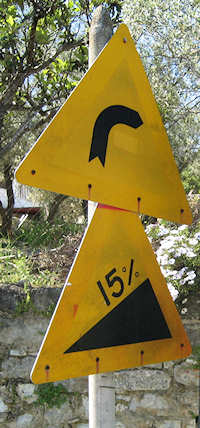Gradient (or slope) of a Line, and Inclination

Application: Road sign, indicating a steep gradient.
A `15%` road gradient is equivalent to `m = 0.15`.
The gradient (also known as slope) of a line is defined as
`"gradient"= text(vertical rise)/text(horizontal run`
In the following diagram, the gradient of the line AB is given by: `a/b`
In general, for the line joining the points (x1, y1) and (x2, y2), we have:
We can now write the formula for the slope of a line.
Gradient of a Line Formula
We see from the diagram above, that the gradient (usually written m) is given by:
`m=(y_2-y_1)/(x_2-x_1`
Interactive graph - slope of a line
You can explore the concept of slope of a line in the following interactive graph (it's not a fixed image).
Drag either point A (x1, y1) or point B (x2, y2) to investigate how the gradient formula works. The numbers will update as you interact with the graph.
Notice what happens to the sign (plus or minus) of the slope when point B is above or below A.
Slope `= (y_2 - y_1)/(x_2 - x_1)`
` =(BC)/(AC)`
Copyright © www.intmath.com
You can move the graph up-down, left-right if you hold down the "Shift" key and then drag the graph.
If you get lost, you can always refresh the page.
Example
Find the slope of the line joining the points (−4, −1) and (2, −5).
Answer
These are the points involved:
So the slope is:
`m=(y_2-y_1)/(x_2-x_1`
`=(-5-(-1))/(2-(-4)`
`=(-4)/6`
`=-2/3`
Note the slope is negative. The line is going "down hill" as we move left to right.
Positive and Negative Slopes
In general, a positive slope indicates the value of the dependent variable (usually y) increases as we go left to right:
The dependent variable in the above graph is the y-value, while the independent variable is x.
A negative slope means that the value of the dependent variable (usually y) is decreasing as we go left to right:
Inclination
We have a line with slope m and the angle that the line makes with the x-axis is α.
From trigonometry, we recall that the tan of angle α is given by:
`tan\ alpha=text(opposite)/text(adjacent)`
Now, since slope is also defined as opposite/adjacent, we have:
This gives us the result:
tan α = m
Then we can find angle α using
α = arctan m
(That is, α = tan-1 m)
This angle α is called the inclination of the line.
Exercise 1
Find the inclination of the line with slope `2`.
Answer
NOTE: The size of angle α is (by definition) only between `0°` and `180°`.
Exercise 2
Find the slope of the line with inclination α = 137°.
Answer
The situation is as follows:
So the slope is:
m = tan α
= tan 137°
= −0.933
Note that the slope is negative.